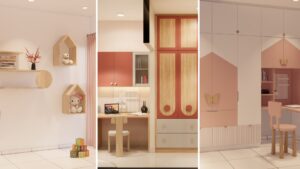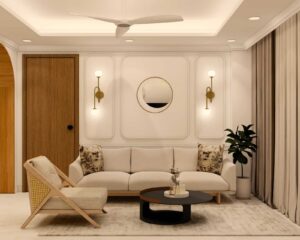In today’s fast-paced world, many individuals seek solace and tranquillity in their homes. This yearning for simplicity, functionality, and elegance has led to a rising interest in minimalist and Japanese interior design principles. In this blog, we will delve into the essence of these design philosophies and how they can transform your residence interior design into a haven of serenity and contemporary style.
Understanding Minimalist Interior Design
Minimalism is more than just a design trend; it’s a lifestyle that prioritizes simplicity and the elimination of excess. This approach focuses on decluttering spaces, emphasizing clean lines, and promoting a sense of calm.
1. Less is More: In minimalist interior design, the mantra “less is more” holds true. This means that you carefully select and display only essential items, avoiding clutter and unnecessary decorations. This approach creates a sense of spaciousness and simplicity.
2. Neutral Color Palettes: Minimalist interiors often feature neutral colour schemes, such as whites, greys, and beige, which provide a serene backdrop for the space. These colours contribute to a sense of tranquillity and timeless elegance.
3. Functional Furniture: Furniture in a minimalist interior is not just aesthetically pleasing; it’s highly functional. Pieces are chosen for their utility and simple, unadorned designs.
4. Clean Lines and Geometric Shapes: Clean lines and geometric shapes are fundamental elements of minimalist design. These elements give a sense of order and balance to the space.
Japanese Interior Decoration: A Harmony of Nature and Tradition
Japanese interior design draws inspiration from nature and traditional Japanese aesthetics. It aims to create an atmosphere of harmony and balance.
1. Natural Materials: In Japanese interior design, the use of natural materials like wood, bamboo, and stone is prevalent. These materials connect the interior with the natural world, fostering a sense of serenity.
2. Shoji Screens and Sliding Doors: Shoji screens and sliding doors are iconic elements of Japanese interiors. They allow for flexible room layouts and provide a sense of privacy without sacrificing openness.
3. Wabi-Sabi: The concept of wabi-sabi is central to Japanese interior decoration. It embraces imperfections, highlighting the beauty of age and simplicity. This philosophy values authenticity and appreciates the passage of time.
4. Minimalistic Furnishings: Japanese interiors typically feature low, minimalist furnishings. The focus is on functionality and comfort, with an emphasis on the use of space.
The Fusion: Contemporary Interior Design Style
The beauty of contemporary style interior design lies in its ability to blend different design philosophies seamlessly. When it comes to combining minimalism and Japanese interior decoration, the result is a space that embodies simplicity, functionality, and serenity.
1. Neutral Color Palettes: Contemporary interior design often incorporates neutral colour palettes, making it compatible with both minimalism and Japanese design. These colours provide a versatile canvas for the fusion of styles.
2. Emphasis on Space: Both minimalism and Japanese interior decoration prioritize open spaces. This shared value promotes a sense of tranquillity and simplicity in contemporary interiors.
3. Natural Elements: The use of natural materials, a hallmark of Japanese interior design, can be seamlessly integrated into contemporary spaces. Wooden accents and stone features add warmth and texture to the environment.
4. Functional Elegance: Contemporary style interior design values functional elegance, aligning with the minimalist principle of choosing furniture for its utility. This ensures that every piece serves a purpose while contributing to the overall aesthetic.
Minimalist and Japanese interior design principles offer a path to a serene and contemporary living space. By embracing the ideals of simplicity, functionality, and harmony with nature, you can transform your residence interior design into a Zen haven that provides comfort and tranquillity in today’s hectic world. Remember, it’s not just about decorating; it’s about creating an environment that nurtures your well-being.


